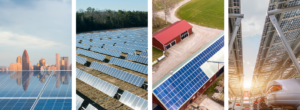
Unleashing the full value of PV monitoring data
Background The rapid deployment of photovoltaic (PV) systems across Europe and globally is a remarkable success story in the transition toward cleaner energy. Yet, behind

Background The rapid deployment of photovoltaic (PV) systems across Europe and globally is a remarkable success story in the transition toward cleaner energy. Yet, behind
🌞Heliocity at the cutting edge of AI in solar energy diagnostics How can I perform preventive maintenance to avoid costly inverter failures, or replace faulty
🌞 Update Your Solar Yield Forecast with Heliocity — A New Feature Focused on Real-World Performance In the photovoltaic sector, the forecasted yield (P50) plays
The deeptech start-up Heliocity SAS was created on September 14, 2020, in Grenoble (France) to support the development of solar energy in the built environment,
The output of a solar power plant depends on the local weather and environmental conditions and its operational condition.
In order to ensure optimum performance, any factors that lead to losses must be minimized and any failures must be resolved without delay.
In order to achieve this goal in the built environment, two key challenges related to the operation and maintenance of solar power plants in this environment need to be overcome:
Frequent underperformance that is difficult to detect due to the concomitance of complex phenomena specific to the built environment that strongly impact the operation of the installation (variable shading, exacerbated dirt, coupling of the solar installation with its own building, urban microclimates, accelerated ageing, etc.).
An expensive operation due to the particular constraints imposed by this type of solar installation (limited access, heterogeneous park, small installations, rough instrumentation…).
These two major difficulties therefore particularly affect the profitability of solar energy production projects in the built environment.
Heliocity’s solutions stand out from the competition thanks to innovative algorithms that allow an unequalled accuracy of anomaly detection, whatever the configuration and instrumentation of solar installations in the built environment.
The prerequisite for a precise anomaly detection is to be able to determine with a high degree of accuracy the expected nominal behavior of the solar installation under its operating conditions. Thus, any deviation from the nominal behaviour reveals an anomaly and the characteristics of the observed deviations make it possible to deduce the root cause.
Our unique approach is based on a patented algorithmic core, Ab Initio, which is the result of more than ten years of research work at the University of Savoie Mont Blanc, at the French National Institute for Solar Energy in Bourget-du-Lac, France. This software core combines multi-physical and multi-scale modeling of buildings, solar systems and the environment with complex data analysis methods adapted to monitoring data.
Thus, even without any weather sensor, Heliocity has a real “digital twin” to which the real installation is compared.
The extreme accuracy of the model allows the detection and diagnosis of any source of losses and gives the owner/operator the information needed to mitigate or correct them.
As an example, the graph below compares the accuracy of Heliocity solutions to an existing solution on the market and illustrates how Heliocity is about 10 times more sensitive.
Our solutions are adapted to all photovoltaic technologies (existing and future). Indeed, we apply a systematic approach to modeling the solar installation based on material properties. It is only a matter of adapting the physical parameters accordingly. The great flexibility of this approach allows us to predict the thermal and electrical response for a range of technologies, from photovoltaic-thermal hybrid sensors, to partially transparent components such as two-sided modules or energy-producing windows, as well as any cell and building integration system technology.

Looking for partners to jointly unleash solar anywhere
© 2020 Heliocity. All rights reserved